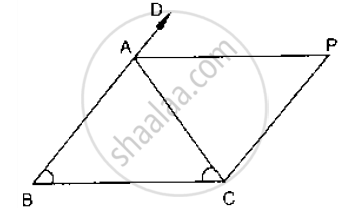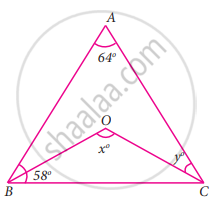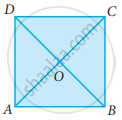Advertisements
Advertisements
प्रश्न
In Fig. below, AB = AC and CP || BA and AP is the bisector of exterior ∠CAD of ΔABC.
Prove that (i) ∠PAC = ∠BCA (ii) ABCP is a parallelogram

उत्तर

Given
AB = AC and CD || BA and AP is the bisector of exterior
∠CAD of ΔABC
To prove:
i) ∠PAC = ∠BCA
ii) ABCP is a parallelogram
Proof:
i) We have,
AB = AC
⟹ ∠ACB = ∠ABC [Opposite angles of equal sides of triangle are equal]
Now, ∠CAD = ∠ABC + ∠ACB
⇒ ∠PAC + ∠PAD = 2∠ACB (∵ ∠PAC = ∠PAD )
⇒ 2∠PAC = 2∠ACB
⇒ ∠PAC = ∠ACB
ii) Now,
∠PAC = ∠BCA
⇒ AP || BC
And, CP || BA [Given]
∴ ABCP is a parallelogram .
APPEARS IN
संबंधित प्रश्न
In a parallelogram ABCD, determine the sum of angles ∠C and ∠D .
P and Q are the points of trisection of the diagonal BD of a parallelogram AB Prove that CQ is parallel to AP. Prove also that AC bisects PQ.
In a parallelogram ABCD, write the sum of angles A and B.
In a parallelogram ABCD, if ∠A = (3x − 20)°, ∠B = (y + 15)°, ∠C = (x + 40)°, then find the values of xand y.
The figure formed by joining the mid-points of the adjacent sides of a rhombus is a
P is the mid-point of side BC of a parallelogram ABCD such that ∠BAP = ∠DAP. If AD = 10 cm, then CD =
In a quadrilateral ABCD, ∠A + ∠C is 2 times ∠B + ∠D. If ∠A = 140° and ∠D = 60°, then ∠B=
In the given figure, ∠A = 64°, ∠ABC = 58°. If BO and CO are the bisectors of ∠ABC and ∠ACB respectively of ΔABC, find x° and y°
ABCD is a square, diagonals AC and BD meet at O. The number of pairs of congruent triangles with vertex O are
Prove that the quadrilateral formed by the bisectors of the angles of a parallelogram is a rectangle.
